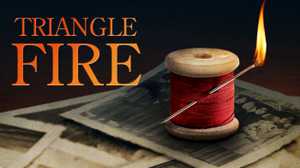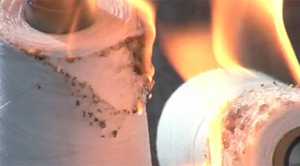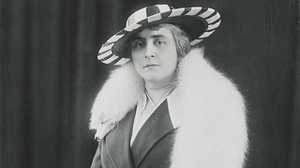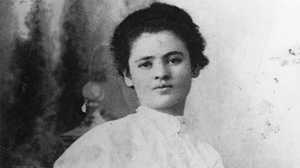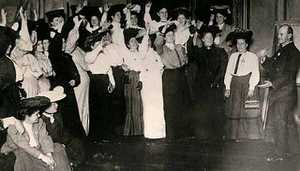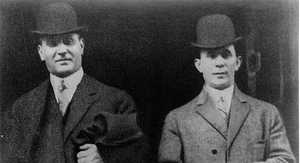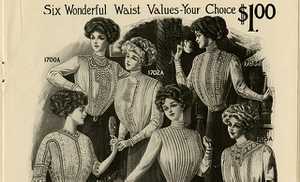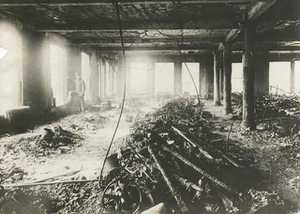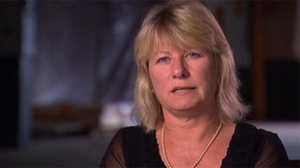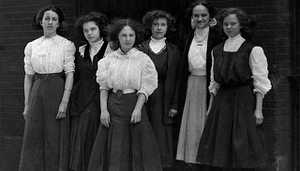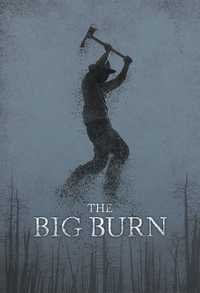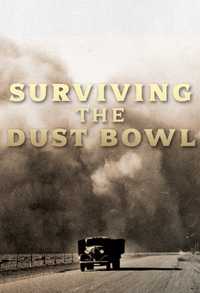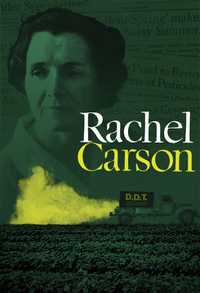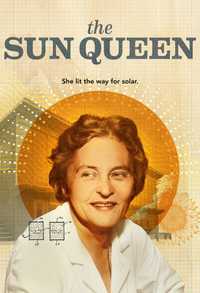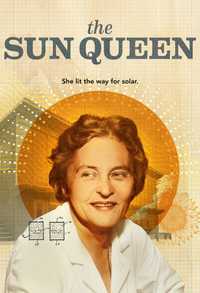Narrator: On April 5, 1911, 400,000 people lined the rain-drenched sidewalks of New York as an empty, horse-drawn hearse crept from the dank, narrow streets of the Lower East Side toward the skyscrapers towering over Madison Square. New Yorkers from all walks of life had come to pay tribute to the unidentified victims of the Triangle fire: the deadliest workplace accident in the city's history. A few weeks earlier, the workers had been forgotten cogs in America's immense industrial machine; now, one in 10 New Yorkers were there to claim them as their own.
Jo Ann E. Argersinger, Historian: Public conscience thought they had failed these young women. They had somehow not protected them.
David Von Drehle, Writer, Writer: There was a recognition: wait these girls can't die in vain. That was said over and over and over again as if the city had somehow turned it's back on them.
Richard A. Greenwald, Historian: If there weren't massive funerals, it would have been very easy for the city and the city officials to say, "Well, this is just, it's sort of a natural disaster. It's a terrible thing, but there's nothing anyone can do about it. "
Annelise Orleck, Historian: If you ask the average American, "Is it okay for workers to work in a shop where the conditions are so dangerous that it could cost them their lives and not have government intervene," most people would say, "No. There's a line." The Triangle Fire drew that line. It burned that line, really, into the nation's conscience.
Narrator: Every morning -- six days a week -- more than 100,000 people poured out onto the streets of the Lower East Side, headed toward another day's work in the city's garment factories. Many were young women in their teens, some were girls as young as 10. They were immigrants, Italians who had fled natural disaster, Jews who had escaped persecution in Russia, Ukraine, Poland. Their families had chosen America for its promise of a better future. But even the youngest daughters had come to understand that their precarious hold on the American dream depended on their willingness to work.
Woman 1 (Meredith Anne Bull): Father had to take me to the shop and not be late for his own work. I was eager to begin life on my own responsibility but was also afraid. "Don't look so frightened," he said.
Annelise Orleck, Historian: These young girls weren't just earning money for their own clothes or to, you know, go out to a dance hall or to Coney Island. They were earning money to support the family.
Richard A. Greenwald, Historian: Economic security was the American dream for many of them. Making enough money to be able to put food on the table, not worry about making rent for the week.
Narrator: As the throng disappeared into sweatshops in tenement apartments, several hundred workers veered off toward the Triangle Shirtwaist factory, in the heart of Greenwich Village.
At the base of the Asch Building, men and women stepped into wooden freight elevators, to ascend to the Triangle factory on the eighth and ninth floors. Workers like Michela Marciano, who managed to send a few dollars to her family in Italy every month, or Julia Rosen whose 17-year-old son worked alongside her to help support three younger children, or Catherine Maltese whose 13-year-old daughter wasn't too young to join her on the factory floor.
Annelise Orleck, Historian: Getting a job in the Triangle Shirtwaist Factory was a pretty desired position because they were working in a much more modern factory environment. High ceilings, big windows. Compared to the coal-stove heated, dusty, hugely crowded sweatshop rooms, Triangle was a plum.
Narrator: But even at the Triangle, sewing machine operators faced a 14-hour workday for $2 a day at most. And that was before bosses docked their pay for the needles, the thread, the electricity they used.
Gussie Schneier (Daniella Rabbani): Sometimes you work at a big machine and it's not working right. One of the needles skips and you get blamed for mistakes.
Pauline Newman (Marta Milans): The same machines, the same surroundings. Shirtwaists, Shirtwaists, and more shirtwaists.
Narrator: On the 10th floor, the Triangle owners could feel their vast machine shuddering below. Max Blanck and Isaac Harris had made Triangle a million-dollar-a-year behemoth, mass-producing the garment every modern woman must have: the shirtwaist. Harris and Blanck were known as The Shirtwaist Kings, but their empire, as they saw it, was under constant siege. After 20 years, the shirtwaist was getting stale. Fashion editors began to showcase colorful dresses for the modern woman and turned up their noses at the bourgeois waist. No matter how much silk embroidery Harris added to their designs, the Triangle's sales charts sloped down. Material and shipping costs seemed always to be rising.
Profit margins matched this year's fashion: "teasingly sheer."
David Von Drehle, Writer: For Max and Isaac there was this constant awareness that they were -- as successful and as rich as they were -- they were one bad season away from being broke. The competition was enormously fierce: 500 blouse-makers on the island of Manhattan alone.
Richard A. Greenwald, Historian: While they're getting the orders from the department stores, there's some small shop a half a mile away that's willing to beat them by half. So it's all about continuous production to get as much cloth turned into a product as possible, at the lowest possible price.
Narrator: That summer there was a growing new threat. All over the city, garment workers were agitating for shorter hours, better pay, safer shops, unions.
Harris and Blanck saw it in the papers every day and on the streets below. Workers were walking off the job by the tens, scores, hundreds. The partners even suspected talk of union on their own shop floor.
Jo Ann E. Argersinger, Historian: Unionization was the single largest fear for most of these employers. They were terrified that unions would come in because that would diminish their authority over the work place.
Narrator: The right to control their own factory was an article of faith for Harris and Blanck -- as for hundreds of business owners just like them. The Triangle partners were in a bracing, daily battle for economic survival. And they meant to control all they could.
Speed mattered more than ever at the Triangle: volume kept Harris and Blanck ahead of their competition. The men had invested in the most up-to-date technology -- and it had to pay. The old pedal pump sewing machines made 34 stitches a minute. With the new electric machines the girls were expected to make 3,000 stitches a minute -- and no mistakes.
Richard A. Greenwald, Historian: An individual worker would be assigned a task whether it was, you know, making collars or buttonholes, and that's what they would do.
Steve Fraser, Historian: They're subject to the rhythms of the machine. They are the slave of that machine and the pace at which it works.
Pauline Newman (Marta Milans): Rubber heels had just come into use and you rarely heard the foreman sneak up behind you, watching.
Sonia Murray (Ami Ankin): He wouldn't let you stop. Not for a drink, the bathroom, nothing.
Woman 2 (Meredith Anne Bull): Sometimes, in my haste, I'd get my finger caught and the needle goes right through it. I bind the finger up with a piece of cotton and go on working.
Annelise Orleck, Historian: Operators were charged for any mistakes that they made. For a lot of these young women whose families depended on their earnings it was very, very stressful. If they messed up a garment, and their pay was docked, they would be left, you know, coming home to tell mom, who always got the pay check, "The family's gonna be hungry this week."
Narrator: Even after the machines powered down for the day, the Triangle workers were subject to one final management imperative: No one left the building before opening her bag to the foreman's inspection at the Greene Street exit.
Max Blanck was kept awake nights calculating the dollars he might lose if workers walked out with shirtwaists tucked in their bags, or fabric, or thread. To ensure that nobody slipped out un-inspected, Blanck ordered that the only other exit -- at Washington Place -- be kept locked.
Steve Fraser, Historian: Bosses are under such intense competitive pressure that they're prepared to ignore under most circumstances the grievances of their workers to treat them like, like shtuka, like animals, like pieces. And they don't fear anything. There's no government intervention. There's no labor legislation. There's really very little sanitary legislation protecting the health and safety of workers. There are no minimum wage laws or maximum hour laws. Nobody's watching!
Narrator: There was release at end of a day's monotonous toil as the women stepped out into the long light of summer.
Alfred Allan Lewis, Writer: The Triangle Shirtwaist Factory was in the middle of New York. If you walked half block you were in Washington Square, lower Fifth Avenue, the great Greek revival homes of the affluent. If you walked to the other side, you were in Broadway, where Wannamaker's store was, where, within a few blocks, what was called "Ladies Mile" was, with all of the wonderful shops.
Steve Fraser, Historian: This is the gilded age. It's an age of extravagant conspicuous consumption.
Thomas Bender, Historian: They can walk up Fifth Avenue and see limestone mansions as far as the eye can see. They can see all around them that there's all kinds of wealth.
Maria Cichetti (Kara Jackson): They were so beautiful, those hats. They were so rich. A woman looked so dressed, you know, in the back, with the bustle. I wanted to grow up to wear earrings and hats and high heels.
Lottie Spitzer (Daniella Rabbani): I liked music. I liked lectures. I wanted to learn things; I wanted to learn everything. The only thing is, the time; I needed time.
Anzia Yezierska (Marta Milans): I used to creep up on the roof of the tenement and talk out my heart to the stars and the sky. Why were we cramped into the crowded darkness? Why are we wasting with want? Where is America?
Narrator: On the morning of October 4, 1909, Harris and Blanck arrived at the Triangle to find their worst fear realized -- their own workers on strike.
They saw this union movement as a personal attack on them; an attack on private property; an attack on the liberty at the heart of America's promise and possibility. Only 20 years earlier, Isaac Harris and Max Blanck had themselves arrived in America -- two young tailors from the shtetls of Eastern Europe -- poor, but ambitious.
As far as they were concerned, they'd built the Triangle Waist Company with their own sweat and ingenuity. They'd risked every hard-won dollar on their dream. And the gamble had earned them each 10-room brownstones uptown with maids, butlers, governesses.
David Von Drehle, Writer: This was the story that was being told all across Europe about what was possible in America. They'd made it. It was the American Dream. The symbol of what it was all about.
Robyn Muncy, Historian: They saw their wealth, their power, as perfectly legitimate reward for their exercise of individual freedom. And that that was the best thing for American society. That was the best thing for the economy.
Narrator: The evidence abounded in New York: Private wealth was building the city's skyscrapers, its parks, museums, libraries and hospitals. And the men who made it happen were celebrated.
Steve Fraser, Historian: These industrial buccaneers are lionized. There is this commitment in American culture to an extreme kind of individualism that individuals, especially the owners of private property, should not be interfered with. That to interfere with them is to place inhibiting obstacles in their path that will restrain prosperity and industrial growth.
Robyn Muncy, Historian: I think a lot of industrialists saw themselves as fairly benevolent, as providing jobs, as providing the means of survival to hundreds and sometimes thousands of workers. And if workers complained about their wages, complained about their hours or the conditions under which they worked, they were biting the hand that fed them.
Narrator: Progressive reformers had been shining a light on the growing inequalities in America for 20 years: The crushing poverty, cramped living spaces and inhumane working conditions. But their calls for government to re-balance the relationship between employers and their employees went largely unheeded. What elected official wanted to put the brakes on the country's remarkable economic engine?
Picketers at the Triangle knew that if they wanted their bosses to treat them fairly, they'd have to force the change themselves.
Steve Fraser, Historian: Winning a union in the shop means establishing a contractual relationship with the boss that covers all the workers in that shop, with respect to not only the wages they work for and the hours that they work, but the conditions under which they work and that their bosses no longer be allowed to get away with what they've been getting away with.
Narrator: Max Blanck and Isaac Harris weren't going to let a bunch of disgruntled factory girls tell them how to run their company. The Triangle owners used "private detective agencies " to provide replacement workers and muscle, bought prostitutes to start fights with the women on the picket lines, and paid off the local police precinct. Their hired thugs beat Triangle strikers; and policemen hauled the picketers into court if they fought back. But every day for six weeks -- in the face of physical abuse and public indifference -- the women took up their places in front of the Asch Building.
The longer the women of the Triangle stood fast, the more workers at other shirtwaist factories paid attention. Week after week the feeling grew: something could be done at their own shops.
Rose Cohen (Kara Jackson): I used to go in the ladies room and a few used to follow me and I was talking to them union.
Eva Goldstein (Ami Ankin): I knew our girls were dissatisfied, I knew other shops were already on strike. I knew it only needed someone to talk to the girls a little and they would join the strikers.
Steve Fraser, Historian: They are in America and they're surrounded by the vocabulary of equality and fairness and that whole language of democracy and they begin to expect something like that for themselves -- real opportunity where they see none; a real voice where they have none.
Narrator: That autumn, on factory floors all over New York, shirtwaist workers were talking about ways to secure equitable pay, reasonable working hours, a bit of control over the safety of their shops, and unions to hold the gains.
At the end of November 1909, when organizers called a meeting at New York's Cooper Union, shirtwaist workers packed the house. The aisles overflowed. The crowd backed up into the street.
And they were all there to consider something unthinkable before the Triangle women had made their stand: a proposal to run an industry-wide strike against each and every one of the city's 500 shirtwaist manufacturers.
Annelise Orleck, Historian: It's a pie-in-the-sky idea. And everyone's trying to talk them out of it. The reformers and the Women's Trade Union League, the senior men and their union, the leadership of the American Federation of Labor, Samuel Gompers himself, is begging them not to do this crazy thing: "None of your families have enough money to sustain a strike. Your younger siblings could starve. You don't wanna do this."
Narrator: While union leaders cautioned against action, a 22-year-old garment worker stepped uninvited to the podium. Everyone at the meeting knew of Clara Lemlich. Just a few weeks earlier when she'd organized a strike at the factory where she'd worked, Lemlich had been beaten by the owners' hired men. She could still feel the sting of six broken ribs.
Clara Lemlich (Amy Ankin): I want to say a few words. I have listened to all the speakers. I have no more patience for talk. I move that we go on a general strike.
David Von Drehle, Writer: And the room goes crazy. There's almost no point in taking a vote, you know. It's like it's unanimous. She's carried the day.
Jo Ann E. Argersinger, Historian: They believed they were going to make history.
Narrator: The next morning, workers in shirtwaist factories across the city awaited some kind of signal.
Rose Perr (Kara Jackson): We all sat at the machines with our hats and coats beside us, ready to leave. And there was whispering and talking softly all around the room among the machines. "Shall we wait like this? Who will get up first?" I started to get up. And at just the same minute all -- we all got up together, in one second. We all stood up, and all walked out together.
Annelise Orleck, Historian: They had calmly put down their scissors and walked away from the only thing standing between them and starvation and between their families and starvation.
Narrator: The women of the Triangle had spurred what was then the largest single work stoppage in the city's history.
Pauline Newman (Marta Milans): Ten thousand, 20,000, this is more than anyone of us dared to dream of or hope for. This is not a strike. This is an uprising.
Narrator: Within 48 hours 70 of the smallest and most vulnerable shirtwaist factories gave in to their workers' demands. They were union-only shops now.
The Triangle bosses were contemptuous of the owners who gave up without a fight. Harris and Blanck organized a manufacturers' association to stand united against the rabble-rousers. And they issued an edict: "No surrender."
Annelise Orleck, Historian: The prostitutes are out there. They're beating them. The police are watching. They're doing nothing.
Richard A. Greenwald, Historian: And it wasn't just women, the prostitutes' pimps would jump in. Triangle would hire ex-prize fighters and known toughs. You'd have people being sent off to the hospital.
Annelise Orleck, Historian: Ribs were being broken, heads were being cracked, and there wasn't a lot of sympathy. When one girl was dragged into court with her head in bloody bandages and the policemen said she'd attacked him, the magistrate believed it and said, "You are on strike against God and nature."
Narrator: Policemen ran strikers into court every day, where judges fined the women, put them in jail, or shipped them to the workhouse on Blackwell's Island. When 10,000 workers marched on City Hall to protest police brutality, the mayor waved them off.
David Von Drehle, Writer: The establishment was against labor unions; the police were against labor unions; city hall was against labor unions.
Narrator: Still, the women went back to their picket lines day after day after day. A handful of Progressive reformers were inspired to join the pickets, but for nearly a month most of the city -- and much of the press -- paid little attention.
David Von Drehle, Writer: At this low moment in the strike, when they're running out of money, the most amazing thing happens: A woman named Anne Morgan decides to take up their cause. Anne Morgan was the daughter of J. Pierpont Morgan, the most powerful financier probably in the history of the world. Here was the face of American capitalism, Morgan, and the idea that his daughter was taking up the cause -- in a public way -- of these radical, often socialist, trade-unionist strikers, walking picket lines in New York was shocking and exciting. I mean the newspapers ate it up. It was great copy.
Annelise Orleck, Historian: They really did believe that the city needed to be reformed and that it was unacceptable to be beating these young girls. And they also believed that they were allies in this campaign for women's suffrage, which was picking up steam. So the mink brigade, the so-called mink brigade, start walking the picket lines and it works.
Narrator: The society ladies' support kept the strike on the front pages. Millionaire socialite Alva Vanderbilt Belmont and Anne Morgan took over a committee to challenge police brutality and to enlist picketers from the uptown crowd.
Annelise Orleck, Historian: If you have someone on the social register walking a picket line, police are going to be a little bit more careful and even private police are gonna be a little more careful about who they club.
Narrator: By the middle of December, Max Blanck and Isaac Harris could feel things turning against them. The mainstream press was now writing sympathetic stories about the striking women -- they had suddenly become "those brave girls." With Christmas approaching and the strikers gaining public support, Harris and Blanck decided it was time to lead their fellow factory owners toward the negotiating table. On the Triangle owners' recommendation, the manufacturers' association agreed to higher wages and shorter hours, if the strikers would drop their demand for union-only shops.
Strike leaders refused.
Their hard-line didn't sit well with Miss Morgan. She was all for individual workers getting better treatment, but she drew the line at fomenting social upheaval.
"I am heartily in favor of these strikers," Anne Morgan told the press, "but these 'fanatical doctrines' are all the more dangerous because they tend to tear down all the good in our present social state." She abruptly resigned from the strike committee.
Alfred Allan Lewis, Writer: She thought they were really trying to turn this into a socialist cause. And she would have none of it. This wasn't about changing the world. Anne Morgan liked most of the world in which she lived.
Narrator: Despite having lost a powerful public advocate, the shirtwaist workers refused to soften their demands. The busy season was right around the corner, and the strikers were betting that owners would want all the experienced hands they could get. One by one, hundreds of shirtwaist manufacturers accepted their workers' demands for a union. And by the middle of February, thousands had returned to union-only shops.
The Triangle strikers weren't so fortunate. When they finally went back on the job, they had won concessions on wages and hours, but Harris and Blanck had forced them to give up the big issue. Triangle workers still lacked real power to improve the worst conditions of the factory floor. There would be no union in the Asch Building.
March 25, 1911 was a Saturday, a short, eight-hour day at the Triangle. As the clock inched toward the end of the shift thoughts drifted toward escape: a long night of freedom beckoned and no work on Sunday.
Woman 2 (Daniella Rabbani): Sometimes we go to Coney Island, where there are good dancing places. I'm very fond of dancing. Many of the young men like to talk to me, but I don't go out with any except Henry. Lately he has been urging me more and more to get married. But I think I'll wait.
Narrator: On the streets below, New Yorkers were already enjoying a leisurely Saturday: bicycling, motoring, strolling the Avenues, window-shopping on Broadway.
David Von Drehle, Writer: Washington Square, you know, is the center of that downtown community so the park was packed with people enjoying the day. And suddenly there's smoke rising over this tower a half a block away.
Narrator: Minutes earlier, a dropped cigarette had started a fire on the eighth floor of the Asch Building. Triangle workers dashed for the stairs, the elevators, and the fire escape. Max Blanck and Isaac Harris on 10 -- warned by phone from below -- made their way to the roof where they scrambled across to the building next door.
In the panic, no one alerted the 200 sewing machine operators on the ninth floor.
Ethel Monick (Kara Jackson): I turned to one of the girls who was putting on her hat and said, "Where does that smoke come from?"
Woman 3 (Daniella Rabbani): Before I could move, everybody in the shop started to scream and holler.
Narrator: Startled machine operators scanned the floor for friends and family, and for the fastest way out. The everyday exit, the Greene Street stairway, was already blocked by smoke and fire. Some women fled out a window and onto the fire escape to the back alley. Others ran toward two tiny passenger elevators that led to Washington Place.
Woman 3 (Daniella Rabbani): The first time the elevator came up the girls rushed in, and it was crowded in a half second. The elevator driver struggled with the door and finally closed it. I was left with those who didn't make the first trip.
Narrator: Sewing machine operators pushed their way down narrow aisles clogged with wicker baskets, loose fabric, their own co-workers.
Mary Bucelli (Marta Milans): I was throwing them out of the way. I was pushing them down. I was only looking out for my own life.
Kate Alterman (Kara Jackson): A young lady began to pull me in the back of my dress. I kicked her with my foot and I don't know what became of her.
Yetta Lubitz (Ami Ankin): I jumped over two lines of machines away from the flames. I looked and I saw an old Italian woman. She couldn't jump over the machines.
Narrator: Panic rose when the women inside heard the overburdened fire escape pull from its masonry, heard the cries of their fellow workers tumbling off the twisting structure. As the smoke grew thicker, some were drawn toward the light of windows overlooking Washington Square.
People were starting to gather at the Asch Building now: passers-by and picnickers, students from nearby New York University, and a young reporter from the United Press.
William Gunn Shepherd (Michael Daly): There was a living picture in each window -- four girls waving their arms. "Call the firemen," they screamed. "Get a ladder." We heard a fire engine in the distance. "Here they come," we yelled. "Stay there."
Narrator: The fire was spreading faster now -- feeding itself on piles of shirtwaists, wooden tables, even the fabric dust that hung in the air. The only precaution the Triangle owners had taken against this sort of disaster -- a dozen red pails of water -- sat impotent in the corners.
The workers who remained inside pushed toward the Washington Place passenger elevator. They knew time was running out. This was probably the last run.
Anna Gullo (Marta Milans): The elevator came up and I was swept into the car by the crowd behind me. The last thing I remember seeing was my sister Marie -- enveloped in flames.
David Von Drehle, Writer: As the elevators descended, workers started jumping into the elevator shaft, first trying to slide down the cable or ride the top of the car but then the crowd behind these women in the open elevator doorways are pushing, pushing to escape from the flames. And now people are being pushed, falling into that elevator shaft.
Narrator: There was one final hope for the trapped Triangle workers: opening the locked door to the Washington Place stairway. But no one had the key.
Kate Alterman (Kara Jackson): I saw Bernstein trying to open the door. He couldn't open it. And then I saw Margaret bending down on her knees. The trail of her dress and the ends of her hair began to burn. And then came a big smoke and I couldn't see. I just knew it was Margaret.
Lena Yaller (Daniella Rabbani): People were screaming about their children and anything else. I noticed Bernstein going around like a wild cat on the windows. Then I saw the flames covering him. Smoke was coming up all around us. I couldn't see anything else. I felt a draft. I wanted to make my way over to where it came from. I wanted to open the window.
Narrator: It had been less than five minutes since the first alarm, but more than a thousand people had crowded around the Asch building. They watched as the firemen raised their ladders to their full extension. They barely reached the sixth floor -- 30 feet shy of the trapped Triangle workers.
Man 1 (Frank Pando): People began to holler, "Raise the ladders! Raise the ladders!" But we had the ladders up.
William Gunn Shepherd (Michael Daly): One girl climbed onto the window sash. Those behind her tried to hold her back. Then she dropped into space.
Man 2 (Joe Lisi): I saw groups of women embracing each other and leaping to the sidewalk. The firemen were helpless. The nets were ripped from their hands, many stooped and picked up the nets again with their hands bleeding.
William Gunn Shepherd (Michael Daly): The last workers were trapped against the blackened windows, burning to death before our very eyes. The glass they were pressed against shattered. Down came the bodies in a shower -- burning, smoking, flaming bodies, with disheveled hair trailing upward.
Man 1 (Frank Pando): The bodies lay there on the sidewalk three or four high, burning, and we had to play the hoses on them.
William Gunn Shepherd (Michael Daly): I looked upon the heap of dead bodies and I remembered these girls were the shirtwaist makers. I remembered their great strike of last year.
David Von Drehle, Writer: The crowd knew the Triangle. They knew the cause of these workers And here, now, of all places this same factory had gone up in flames and hundreds of these workers who had said that the conditions were not safe, that the fate of workers was perilous in New York, the justice of the strikers' cause had been underlined in blood on these sidewalks.
Narrator: Thirty minutes after the initial call, the New York City Fire Department had the blaze at the Triangle under control. Three hours later, firemen began lowering bodies by block-and-tackle.
New York City policemen -- some of them the same men who had beaten the picketing workers -- leaned out of windows on each floor to make sure the bodies didn't bang against the side of building as they descended from the Triangle Waist Company for the final time. Others catalogued the personal belongings strewn on the sidewalks: a broken hair comb, a patent leather Oxford with the laces still tied in a knot, a rosary, a fur-trimmed hat with a crushed red rose.
Even the most hardened policemen buckled; the crew had to be changed almost every hour. When the last body was removed just after midnight, the total number of dead stood at 145.
Fifty-three had jumped or fallen from the windows. Nineteen fell in the elevator shaft. More than 20 tumbled off the fire escape. And at least 50 burned to death on the factory floor. All but 23 of the dead were women, nearly half of them teen-agers. One jumper had miraculously survived. She lay near death in St. Vincent's Hospital.
The morning after the fire, friends and relatives of the Triangle workers gathered outside a temporary morgue on the East River, where the bodies were lined up for identification each under white cloth, heads pillowed up for viewing.
David Von Drehle, Writer: People were invited to come in and try to identify children, or wives, or husbands, or boyfriends, or daughters, or girlfriends who had not come home all night.
Man 3 (Frank Pando): I had to get Mary identified; she was burned beyond recognition. The dentist opened her mouth and recognized his work.
Esther Rosen (Daniella Rabbani): It was Mama's hair. I braided it for her. I know... I know.
Salvatore Maltese (Joe Lisi): I've been to the morgue three times and looked over 20 charred bodies. None of them can I recognize as my wife.
Narrator: The fire claimed its final victim on March 30, 1911, when the surviving jumper died. In death, she was no longer anonymous. She was Sarah Kupla, a 16-year-old sewing machine operator mourned by her family in the Bronx.
Newspapers, public officials, the wider world had begun to attach names to these Triangle workers by then: Rosie Bassino and her sister Irene; Max Lehrer and his brother Sam; Mary Goldstein; the Saracino sisters; Michela Marciano, who had survived an eruption of Mt. Vesuvius before emigrating to America; Rose Manofsky, whose little sister had lost her sole source of support; and Salvatore Maltese, who had buried every female in his household: his wife Catherine, his 20-year old daughter Lucia and his daughter Rosaria, who was -- at 14 -- the fire's youngest victim.
Families of the victims took some small measure of comfort from a sympathetic public. New Yorkers raised money to pay for burials, to support dependents left behind, or to replace the weekly cash envelopes Triangle workers had sent to their families in Europe.
Survivors also hoped for some small measure of justice when Isaac Harris and Max Blanck were brought up on charges of manslaughter and were shattered when the two men were acquitted. The state failed to prove beyond a reasonable doubt that the two men knew the exit door was locked at the time of the fire.
The Shirtwaist Kings would take their insurance settlement and fade into obscurity. The Triangle factory -- and the memory of the women who worked there -- would not.
Thomas Bender, Historian: People were realizing that they had tolerated a kind of set of employment and other industrial practices that they should never have tolerated. What people had been saying, that you can't have unregulated industrialization, that there are things that have to be managed not by the market but by public policy, this now rang true in a way that it didn't the day before.
Richard A. Greenwald, Historian: It opens wide a system that was for so long seen as a private system between a worker and an owner. It essentially says at that point that it's no longer private. It can never be private again. There are 146 women, men who died because that was a private system. That doesn't work.
Narrator: In the aftermath of the Triangle fire, an enraged public compelled government to act.
The New York State Legislature funded a factory safety commission, which held months of hearings, collected testimony from hundreds of owners and workers, and inspected nearly two thousand factories.
Within two years, the commission's shocking findings spurred the passage of more than 30 new laws. They set standards for minimum wages, maximum hours and workplace conditions, gave teeth to child labor laws, and addressed each and every failure at the Triangle factory.
Jo Ann E. Argersinger, Historian: And New York does become a model, clearly inspired by these young women. I think Sam Gompers said it best that rarely do you get an opportunity for such legislative reform, but women had to burn first in order for this to happen.
Woman 1 (Kara Jackson): I dreamed about the fire at night, and I would dream that I was falling out of the window, screaming. I remember hollering to my mother in the dark. "Mama, I just jumped out of the window."
